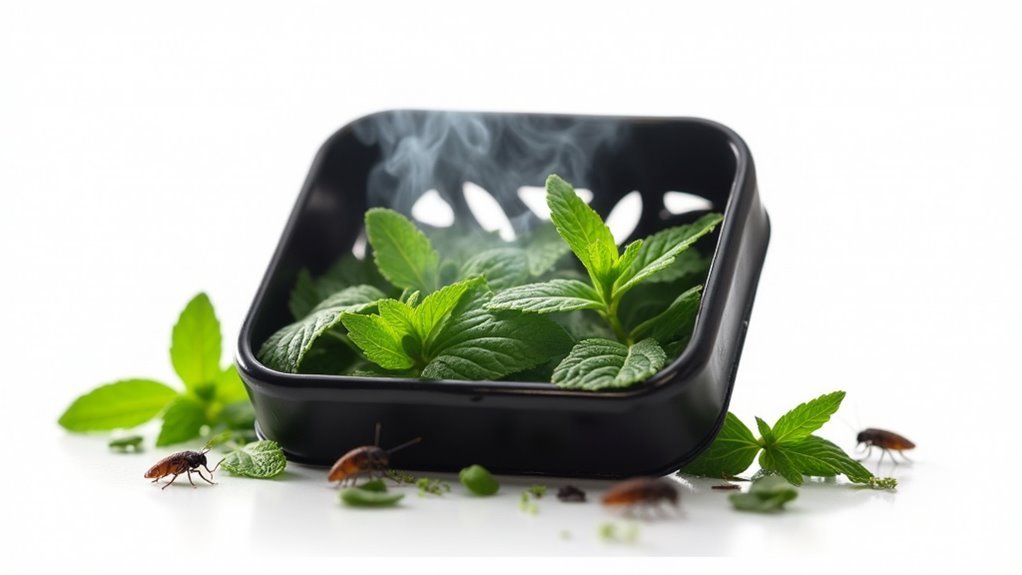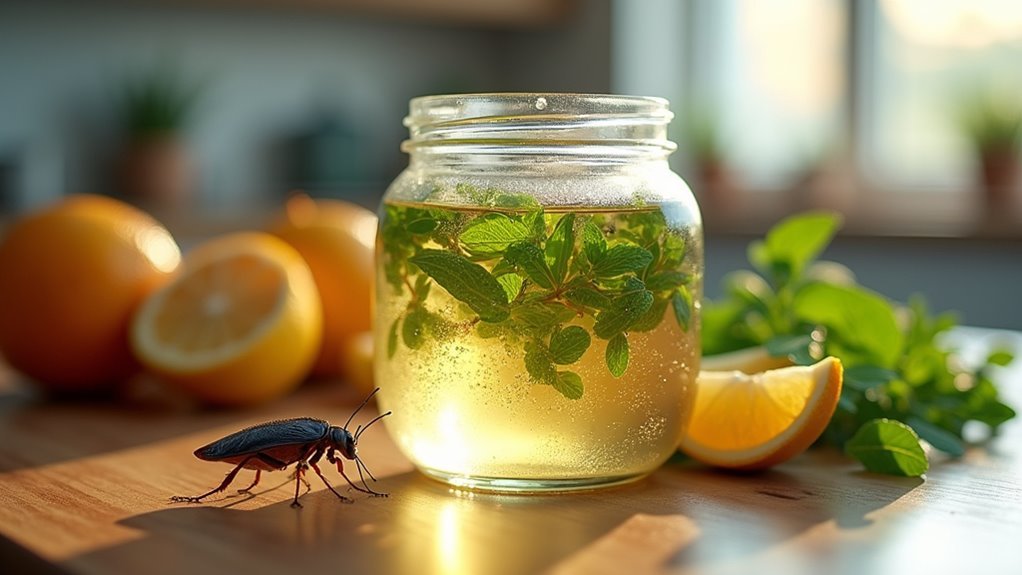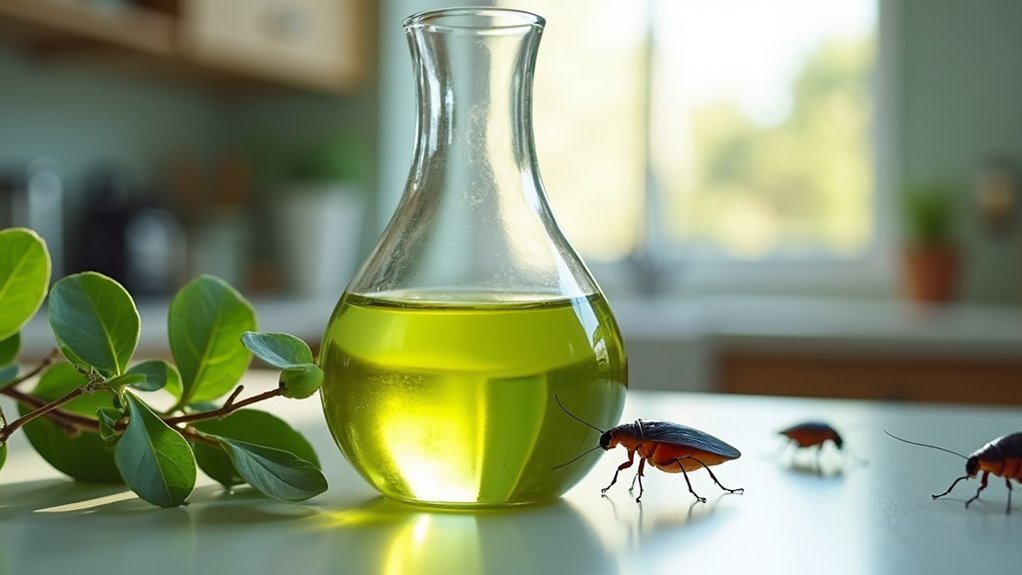You can create effective essential oil traps by soaking cotton balls in peppermint, eucalyptus, or oregano oil and placing them in cockroaches’ preferred hiding spots like under sinks and behind appliances. Mix 10-15 drops of essential oil with one cup of water for spray applications targeting kitchen corners and entry points. Replace cotton balls every 5-7 days and reapply sprays every 3-4 days for maximum potency. Strategic combinations and proper maintenance techniques will maximize your natural pest control success.
Understanding How Essential Oil Traps Work Against Cockroaches

When you’re dealing with a cockroach infestation, essential oil traps offer a natural alternative that exploits these pests’ heightened sensitivity to certain scents.
These traps function as an effective natural repellent by using strong scents from oils like peppermint and eucalyptus to disrupt cockroaches’ sensory receptors. The overwhelming aromas create an inhospitable environment that deters these pests from entering treated areas.
Essential oil traps create powerful scent barriers that overwhelm cockroaches’ sensory systems, making treated areas uninhabitable for these persistent pests.
You’ll find that essential oils interfere with cockroaches’ navigation abilities and communication patterns, making it difficult for them to locate food sources and mates.
To create these traps, soak cotton balls in your chosen essential oils and place them strategically around your home. The concentrated repellent properties overwhelm cockroaches when they encounter these scented barriers, effectively keeping them away from the treated zones.
Why Cockroaches Avoid Certain Essential Oil Scents
Cockroaches possess remarkably sophisticated olfactory systems that make them extremely vulnerable to the concentrated compounds found in certain essential oils. When you use strong scents like peppermint, eucalyptus, oregano, or rosemary, you’re disrupting their basic survival mechanisms.
These essential oil scents overwhelm their sensitive receptors, interfering with their navigation abilities and making it impossible for them to locate food sources effectively.
You’ll find that cockroaches actively avoid areas where these potent aromas are present because the scents disrupt their communication systems. They can’t find mates or establish territories when essential oils create an inhospitable environment.
Compounds like cineole in eucalyptus oil specifically interfere with their feeding and movement patterns. These strong scents signal danger to cockroaches, effectively helping essential oils repel them from your space.
Top Essential Oils for Creating Effective Cockroach Traps

Several essential oils stand out as particularly powerful allies when you’re creating cockroach traps that actually work.
Peppermint oil’s strong menthol aroma disrupts cockroaches’ navigation and communication, making it difficult for them to locate food sources.
Eucalyptus oil contains high cineole levels that demonstrate notable repellent effects against these pests.
Lavender oil serves as a natural deterrent while creating a calming scent that masks attractive odors.
However, oregano oil delivers the most impressive results, showing up to 99.1% repellency rates in laboratory settings.
To create an effective cockroach trap, combine 10-15 drops of your chosen essential oil with water and sugar in a shallow dish.
This mixture attracts cockroaches while leveraging the repellent properties of these powerful essential oils.
Peppermint Oil: The Most Potent Cockroach Deterrent
Although oregano oil claims the highest laboratory repellency rates, peppermint oil emerges as the most practical and potent cockroach deterrent for everyday use.
While oregano oil tops laboratory tests, peppermint oil proves most effective for practical, everyday cockroach control in homes.
The menthol in peppermint oil disrupts cockroaches’ navigation and communication systems, making it an effective deterrent. Research shows this oil achieves 59.1% to 68.8% repellency against brown-banded cockroaches. The strong scent overwhelms their olfactory receptors, causing disorientation that prevents invasion.
You can create a DIY spray by mixing 10-15 drops of peppermint oil with one cup of water. Target areas where cockroaches typically hide to repel them effectively.
However, you’ll need consistent reapplication since the scent dissipates over time, and cockroaches may return without ongoing deterrent maintenance.
Eucalyptus Oil Applications for Maximum Repellent Power

You’ll achieve maximum cockroach repellent power with eucalyptus oil by creating the right spray solution and placing it strategically throughout your home.
The key lies in mixing 10-15 drops of eucalyptus oil with one cup of water in a spray bottle for ideal concentration.
Your success depends on targeting the right locations where cockroaches hide and travel most frequently.
Spray Solution Preparation
Eucalyptus oil creates one of nature’s most potent cockroach deterrents when properly mixed into a spray solution.
You’ll need to combine 1 cup of water with 10-15 drops of eucalyptus essential oil to create an effective repellent. The oil’s high cineole content disrupts cockroaches’ navigation and feeding patterns, making it particularly powerful against these pests.
Apply your spray solution around kitchens, corners, and entry points where cockroaches commonly hide. You’ll need consistent reapplication every few days to maintain the deterrent’s effectiveness.
Consider enhancing your mixture by adding peppermint or tea tree oil drops for broader pest-repelling properties. This combination approach maximizes your essential oils’ impact while creating a thorough barrier that cockroaches actively avoid.
Strategic Placement Methods
Creating an effective spray solution sets the foundation, but proper placement determines your success in repelling cockroaches. Strategic placement of eucalyptus oil guarantees maximum deterrent power against these unwanted pests.
Target high-activity areas where cockroaches typically hide and travel. Spray your eucalyptus oil solution around corners, under sinks, and behind appliances. Soak cotton balls in the essential oil and position them in dark, damp spaces for continuous protection.
| Location | Method | Reapplication Frequency |
|---|---|---|
| Kitchen corners | Spray solution | Every 3-4 days |
| Under sinks | Cotton balls | Weekly |
| Behind appliances | Oil diffuser | Continuous |
| Bathroom crevices | Spray solution | Every 2-3 days |
Regular reapplication maintains the oil’s repel effectiveness, especially in humid environments. This strategic approach creates potent barriers that effectively deter cockroach infestations.
Tea Tree Oil Benefits in Homemade Roach Control
When it comes to natural pest control, tea tree oil stands out as one of the most potent weapons against cockroaches in your arsenal. This essential oil’s antiseptic properties and strong, pungent aroma make it an excellent repellent that disrupts sensory receptors in roaches, effectively deterring them from your home.
You can create effective homemade roach control solutions by mixing 10-15 drops of tea tree oil per cup of water in a spray bottle. Apply this mixture to areas likely to hide cockroaches, or soak cotton balls in the oil and place them in corners and crevices.
Studies confirm tea tree oil repels various cockroach species, making it a versatile pest control option. Remember that regular reapplication is essential since the scent diminishes over time.
Creating DIY Essential Oil Spray Traps
While tea tree oil offers proven roach-repelling benefits, you can expand your natural pest control arsenal by crafting versatile DIY essential oil spray traps that target cockroaches throughout your home.
Mix one cup of water with 10-15 drops of potent essential oils like peppermint or eucalyptus in a spray bottle. Focus application around kitchen corners, cracks, and entry points where cockroaches hide and travel.
For enhanced effectiveness, soak cotton balls in essential oils and place them strategically in hidden areas. This creates scent barriers that effectively repel these unwanted pests.
You’ll need to reapply the spray every few days since the potency diminishes over time. Combine this natural pest control method with diatomaceous earth or traps for thorough cockroach management.
Cotton Ball Placement Strategy for Essential Oil Distribution
You’ll maximize your essential oil trap effectiveness by targeting cockroaches’ preferred hiding spots with strategically placed cotton balls.
Focus on saturating each cotton ball thoroughly with oils like peppermint or eucalyptus, then position them under sinks, behind appliances, and in dark corners where roaches commonly travel.
Replace these oil-soaked barriers every 2-3 days to maintain their potency and guarantee continuous pest deterrence.
Strategic Placement Areas
Although cockroaches can hide in countless locations throughout your home, targeting specific strategic placement areas with cotton balls soaked in essential oils dramatically increases your success rate.
Focus on common hiding spots like under sinks, behind appliances, and cabinet corners where these pests frequently gather. Position cotton balls soaked in peppermint or eucalyptus oils near entry points such as doorways and windows to create protective barriers.
Don’t overlook less accessible areas behind furniture and inside wall voids where cockroaches nest. This strategic approach maximizes repellent effectiveness by ensuring broad coverage.
Combine this method with cleanliness and crack sealing for an all-encompassing approach that’ll enhance ongoing deterrent effects, making your essential oil strategy effective at driving cockroaches away permanently.
Oil Saturation Methods
When you saturate cotton balls with essential oils, you’re creating powerful repellent stations that disrupt cockroaches’ navigation and communication systems.
The oil saturation method involves soaking cotton balls in potent essential oils like peppermint, eucalyptus, rosemary, or tea tree oil to effectively repel cockroaches.
To maximize effectiveness:
- Strategically position saturated cotton balls in hidden corners, under sinks, and near entry points
- Combine different essential oils on separate cotton balls to enhance repellent properties
- Replace cotton balls weekly as the strong scents lose potency over time
- Re-soak regularly to maintain ideal oil concentration
The overwhelming scent creates barriers that deter cockroaches from entering treated areas.
You’ll need to make sure cotton balls are re-soaked regularly since essential oils evaporate, diminishing their cockroach-repelling effectiveness.
Replacement Frequency Guidelines
Since essential oils naturally evaporate and lose their potency, you’ll need to establish a consistent replacement schedule to maintain effective cockroach deterrence. Following proper replacement frequency guidelines guarantees your cotton balls retain their effectiveness.
Replace soaked cotton balls every 1-2 weeks, as regular reapplication prevents scent diminishment that reduces repellent properties.
To maximize results, generously soak fresh cotton balls and position them in high-traffic areas where cockroaches typically hide, including behind appliances and dark corners.
Rotate different essential oils during each replacement to prevent cockroaches from adapting to familiar scents. Regular inspection prevents dust and moisture buildup that compromises efficacy.
Consider placing cotton balls in sealed containers with small openings to prolong scent potency while allowing proper aroma dispersal throughout your targeted areas.
Building Oil Diffuser Stations Around Your Home
Three strategic locations in your home can become powerful cockroach deterrent zones when you establish oil diffuser stations there. Focus on kitchens, bathrooms, and entry points where cockroach control becomes critical.
Your oil diffuser stations should utilize essential oils with proven repellent properties like peppermint oil, eucalyptus, and tea tree oil to disrupt roach navigation patterns.
For maximum effectiveness, consider these key strategies:
- Operate diffusers during peak roach activity times, typically at night
- Use nebulizing diffusers that disperse pure oils without water dilution
- Blend multiple essential oils to create stronger deterrent effects
- Clean stations regularly to prevent residue buildup
Nebulizing diffusers provide superior coverage and potency, ensuring your essential oil barriers remain consistently effective against unwanted cockroach visitors throughout your home.
Combining Multiple Essential Oils for Enhanced Effectiveness
While single essential oils can deter cockroaches effectively, you’ll achieve dramatically better results by creating custom blends that target multiple sensory pathways.
Combining essential oils like peppermint, eucalyptus, and tea tree oil creates synergistic effects that enhance their repellent properties. Research shows that rosemary and eucalyptus blends achieved 100% cockroach repellency rates.
Mix 10-15 drops of different oils in one cup of water using a spray bottle to enhance effectiveness when treating hiding spots. This combination of oils targets various sensory receptors, making it harder for cockroaches to adapt.
You’ll create a more robust barrier by incorporating oregano and yarrow with traditional peppermint oils, ensuring long-term success against these persistent pests.
Proper Concentration Ratios for Safe Yet Effective Results
How concentrated should your essential oil mixture be to effectively repel cockroaches without creating safety concerns? The key lies in finding the right balance between potency and safety when determining concentration ratios.
Start with these proven guidelines for your essential oil mixture:
Follow these tested concentration ratios to create an effective cockroach repellent that balances potency with household safety.
- Mix 1 cup of water to create your base solution with 10-15 drops of essential oils for maximum effectiveness.
- Begin with lower concentrations (5-10 drops) to test sensitivity before increasing strength.
- Use a 10% concentration ratio for potent oils like tea tree or rosemary to enhance repellent properties.
- Combine peppermint and eucalyptus oils in equal ratios for improved cockroach deterrence.
Remember that regular reapplication every few days guarantees effective results, as the strong aroma naturally dissipates over time.
Strategic Trap Placement in High-Activity Cockroach Areas
Once you’ve prepared your correctly concentrated essential oil mixture, success depends heavily on where you position these traps throughout your home.
Focus on high-activity areas where cockroaches naturally congregate: kitchens, bathrooms, and dark corners with food debris and moisture. Strategic placement near entry points like windows and doors intercepts roaches before they establish themselves in living spaces.
Position your peppermint and eucalyptus traps underneath sinks and behind appliances where cockroaches seek water sources and shelter.
You’ll maximize effective repelling by combining different essential oils in each trap location. Don’t scatter traps randomly—concentrate them in these proven hotspots.
Replace your traps every few days to maintain their potency and continue deterring roaches from returning to previously infested areas.
Maintenance Schedule for Consistent Essential Oil Protection
You’ll need to reapply your essential oil traps every 5 to 7 days to maintain their cockroach-repelling power.
Cotton balls and soaked materials lose their potency as oils evaporate, so replace them when they’ve dried out or weakened.
Monitor how well your traps are working by watching cockroach activity levels and adjusting oil concentration accordingly.
Reapplication Frequency Guidelines
Maintaining effective cockroach deterrence requires strategic timing when revitalizing your essential oil traps. Your reapplication frequency directly impacts how well these cockroach repellents maintain effectiveness against unwanted pests.
Follow these timing guidelines to create a protective environment:
- Cotton ball traps: Replace every 5-7 days for consistent barrier protection
- Spray solution: Reapply every 3-4 days in high-traffic areas where cockroaches commonly travel
- General maintenance: Refresh all essential oils every 1-2 weeks under normal conditions
- After disruptions: Immediately reapply following heavy rainfall or deep cleaning sessions
Your pest control success depends on consistency. Essential oils lose potency as their scent diminishes, so you can’t rely on sporadic applications.
Inspect your traps regularly and stick to this schedule for maximum deterrent power.
Monitoring Oil Effectiveness
While essential oil traps provide powerful cockroach deterrence, their effectiveness depends entirely on your ability to track their performance and maintain ideal potency levels.
Monitor areas around your traps weekly for cockroach droppings, sightings, or other activity signs. Document which essential oils work best in different locations by noting changes in cockroach presence after reapplication.
Create a simple tracking system recording trap locations, oil types used, and observed results. If you notice increased cockroach activity despite fresh traps, consider rotating between peppermint and eucalyptus oils monthly to prevent adaptation.
Clean the environment around traps regularly, removing food sources that might counteract your oils’ ability to repel cockroaches. This systematic monitoring approach guarantees your essential oil strategy remains effective long-term.
Integrating Essential Oil Traps With Other Natural Pest Control Methods
Although essential oil traps work effectively on their own, combining them with complementary natural pest control methods creates a more robust defense against cockroach infestations.
You’ll maximize your pest control efforts by implementing these natural solutions alongside your essential oils strategy.
Consider these effective method combinations:
- Diatomaceous earth enhancement – Mix food-grade diatomaceous earth with your essential oil traps for dual-action control that physically eliminates cockroaches while maintaining repellent properties.
- Traditional bait integration – Place conventional baits near your oil traps to utilize both attractant and repellent mechanisms simultaneously.
- Ultrasonic device pairing – Combine sound wave deterrents with essential oils to establish a thorough barrier against infestations.
- Rigorous sanitation practices – Seal food sources and eliminate crumbs to create an inhospitable environment that amplifies your natural pest control effectiveness.
Frequently Asked Questions
Which Essential Oil Keeps Roaches Away?
You’ll find peppermint oil most effective at repelling roaches due to its strong menthol scent. Oregano oil’s also incredibly powerful, showing 99.1% repellency rates. Eucalyptus and lavender oils work well too for natural deterrence.
What Smell Do Cockroaches Hate Most?
You’ll find cockroaches hate peppermint oil’s strong scent most, as it disrupts their navigation systems. Oregano oil’s also extremely effective, achieving 99.1% repellency rates in tests by overwhelming their sensory receptors completely.
What Is the Best Cockroach Deterrent?
You’ll find oregano oil works best as a cockroach deterrent, showing 96.5-99.1% effectiveness in studies. Blend it with peppermint or eucalyptus oils for stronger results, and reapply regularly to maintain potency.
How Do I Get Rid of Roaches Permanently?
You’ll need rigorous sanitation, sealing entry points, and combining essential oil traps with diatomaceous earth. Monitor regularly and reapply treatments consistently. For severe infestations, consider professional pest control services.
In Summary
You’ve now got the knowledge to create powerful essential oil traps that’ll keep cockroaches away from your home. Remember, you’ll need to maintain consistent concentration ratios and refresh your traps regularly for best results. Don’t forget to place them strategically in high-traffic areas where roaches are most active. By combining these natural methods with other pest control techniques, you’ll establish an effective, chemical-free defense system that protects your family while eliminating unwanted pests.





Leave a Reply